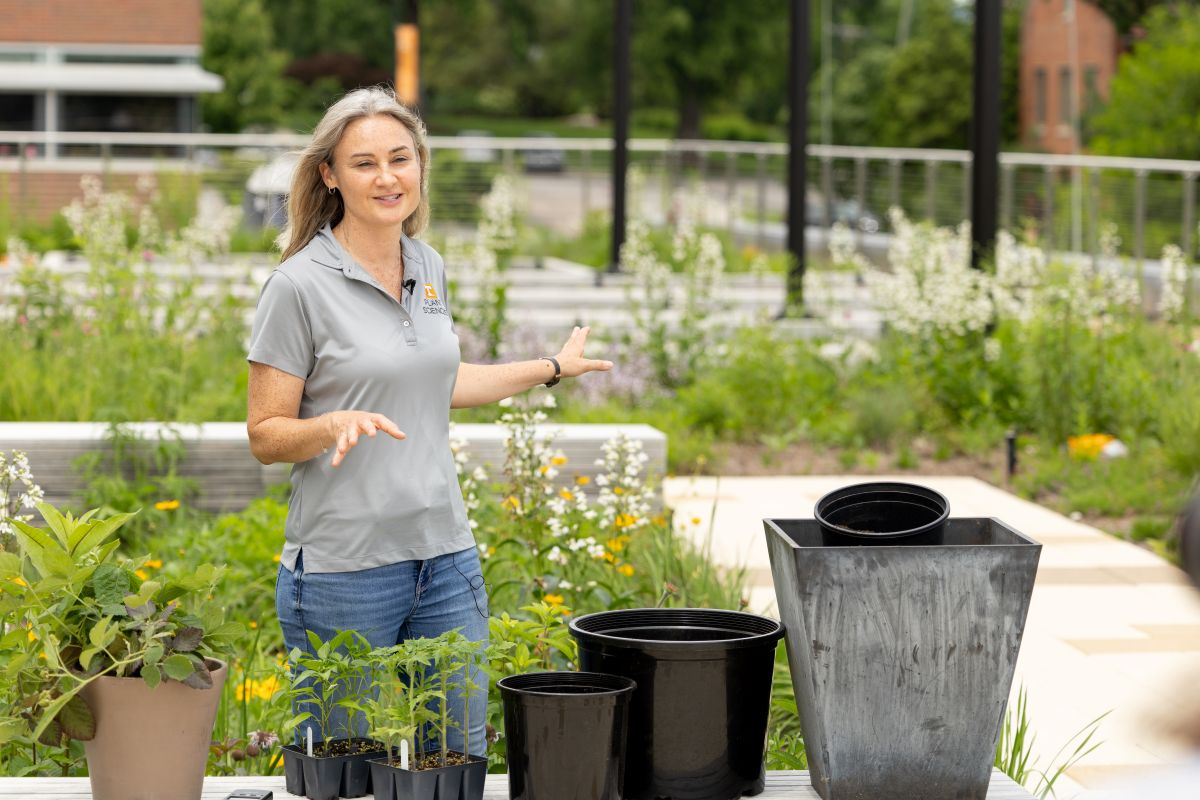
UTIA Horticulture Experts Explain How To Grow Vegetables and Fruit on Your Patio, Deck or Balcony
KNOXVILLE, Tenn. – The heat of summer has arrived with farmers markets and home gardens filling up with delicious vegetables and fruit. Think it’s too late to start your own garden even if you only have a patio or deck with a few pots? Horticulture experts at the University of Tennessee Institute of Agriculture have a plan for you.
In a series of UT Extension publications about small-space food production, horticulture specialists explain how home gardeners can make the most of the space they have. They recommend several options that grow quickly, such as cucumbers, that home gardeners can start now and harvest soon. Also, there are plenty of cool-season crops to plant for the fall.
The UT Extension publication Small-space Outdoor Food Production (listed in the UT Extension online publication catalog as publication W 1288-A) is a good start for finding the best site, light and media for your small space. This publication is written by Natalie Bumgarner, residential and consumer horticulture specialist, agriculture and natural resource agents Amy Dunlap from Davidson County and Haley Treadway from Hamilton County, and Tennessee State University Extension agent Madison O’Ferrall from Giles County.
Consider the Location
For any garden, whether large or small, the first thing to consider is sunlight. Count the number of hours of sunlight available in the area where you wish to plant. Fruiting vegetables such as tomatoes, peppers, okra and vine crops and small fruit crops will need six to 10 hours of sunlight for good growth and production. Some root and leafy vegetables are fine with four to six hours. Pay attention to whether the sun hits this area in the morning or afternoon. Notice how much heat, air movement and rainfall this area receives.
The Best Size
The size of your container will determine what crop will grow the best and how much watering is necessary. The material of the container also will determine how often to water. For instance, plastic containers dry out slower than terracotta. Good crops for one-gallon containers include beets, Swiss chard, lettuce, mustard/turnip greens, onions, garlic, radishes, dwarf cherry tomatoes and herbs such as basil, cilantro, parsley, oregano, sage and mint. Check W 1288-A for more size recommendations.
Choose the Right Media
If you are growing in a container, you will need proper growing media rather than soil. Growing media or potting mix contain peat moss, coconut coir, composted pine bark and natural materials such as sand, perlite and vermiculite. When purchasing media, check the label to see what is in it. For smaller growing containers, use media that has primarily peat moss and compost to hold water and perlite to support aeration and drainage. For larger containers, a mix that has similar volumes of peat moss, compost and pine bark would be a good choice to provide weight, water and nutrient-holding capacity and drainage. Pine bark also is a benefit because the larger particles do not break down as quickly as smaller peat particles.
Watering Basics
Worried about overwatering or underwatering? As a general rule, watering should be done until water drains out of the bottom of the container to ensure water reaches all the media. Make sure your container is not sitting continually in water. The best time to water is in the morning. Avoid getting the leaves wet. Use your hand to check to see how moist the media is and how far down. The goal is for the upper portion of the container to dry out between waterings but for the entire container to not be dry. Don’t forget to put a tray under your pots if they are on a balcony above your neighbors!
Plant Nutrition
Soilless plant mixes have a low level of plant nutrients. Controlled release fertilizers can be added early in the season to slowly provide plant nutrients. Tomatoes and leafy crops generally need more nutrients and can benefit from the use of soluble fertilizers once or twice a month. Distribute top dress fertilizers evenly over the surface area or utilize water soluble fertilizer options. Follow the directions on the product.
What to Plant
UT Extension publication Crops and Cultivars for Small-space Food Production (W 1288-C) contains lists of warm-season, cool-season and herb cultivars recommended for containers. These lists include the days to harvest when planting from seed, but what if you’re just starting to plant during the summer? Many cucumbers and squash can be harvested 40-50 days after seedings, so there can still be time to obtain a good harvest. Using transplants can be a way to shorten the time to harvest—just be careful to purchase high-quality plants that haven’t been stressed.
If time has gotten away from you for warm season crops, you can get a jump on cool season vegetables by planning now. Many crops can be grown directly from seed starting in August and September. These include arugula, turnips, beets, Swiss chard, kale, and leaf lettuce. Broccoli, cabbage, collards, and kale can be started from seed in July for transplanting in August or September. There is still time to order a wide range of seeds from online suppliers or purchase from garden centers.
More Online Resources from UT Extension
Video: Beginner Tips for Small-space Food Production with Natalie Bumgarner
Video: Crops and Cultivars for Small-space Food Production with Natalie Bumgarner
Video: Introduction to Small-space Food Production with Amy Dunlap
Video: An Overview of Containers and Media for Small Spaces with Natalie Bumgarner
Website: UT Hort, a hub for research-based horticulture information
The University of Tennessee Institute of Agriculture is comprised of the Herbert College of Agriculture, UT College of Veterinary Medicine, UT AgResearch and UT Extension. Through its land-grant mission of teaching, research and outreach, the institute touches lives and provides Real. Life. Solutions. to Tennesseans and beyond. utia.tennessee.edu.